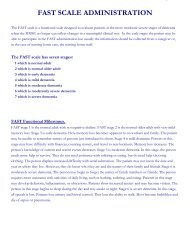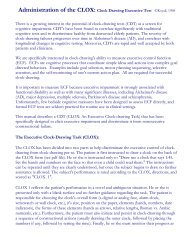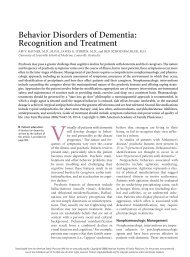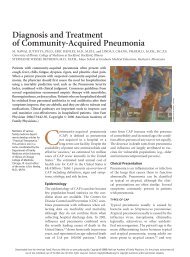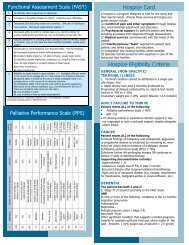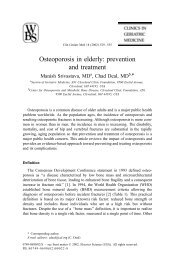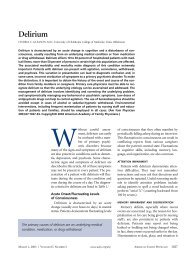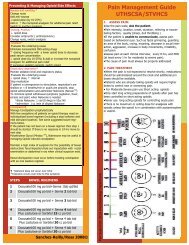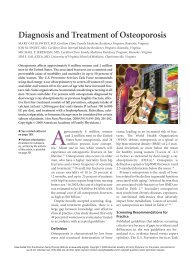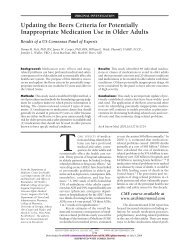the mini-cog - John A. Hartford Center of Excellence in Geriatrics ...
the mini-cog - John A. Hartford Center of Excellence in Geriatrics ...
the mini-cog - John A. Hartford Center of Excellence in Geriatrics ...
You also want an ePaper? Increase the reach of your titles
YUMPU automatically turns print PDFs into web optimized ePapers that Google loves.
give <strong>the</strong> M<strong>in</strong>i-Cog <strong>in</strong> `real world' sett<strong>in</strong>gs. Its<br />
structure is simple enough to be used by community<br />
volunteers and health care personnel, provided<br />
its most vulnerable element, <strong>the</strong> CDT, can be<br />
scored correctly.<br />
Many CDT dementia screen<strong>in</strong>g systems have<br />
been proposed, with vary<strong>in</strong>g degrees <strong>of</strong> complexity<br />
(Watson et al., 1993; Shulman et al., 1986; Dastoor<br />
et al., 1991; Tuokko et al., 1992; Death et al., 1993).<br />
While all studies report <strong>the</strong> sensitivity and speci-<br />
®city <strong>of</strong> <strong>the</strong>ir proposed systems, cost±bene®t,<br />
measured <strong>in</strong> ease <strong>of</strong> use, is rarely exam<strong>in</strong>ed. If a<br />
scor<strong>in</strong>g system slightly improves sensitivity or<br />
speci®city but <strong>in</strong>creases costs <strong>in</strong> terms <strong>of</strong> complexity,<br />
<strong>in</strong>terpretation and tra<strong>in</strong><strong>in</strong>g, <strong>the</strong>n many CDT<br />
advantages are lost. As analog clock form and<br />
function are highly learned <strong>in</strong> most modern<br />
cultures, we believe that understand<strong>in</strong>g how to<br />
judge CDTs as `normal' and `abnormal' is <strong>in</strong>tuitively<br />
and widely understood. Therefore, if naõÈ ve<br />
raters gave <strong>the</strong>ir best estimates without an explicit<br />
scor<strong>in</strong>g system, <strong>the</strong>ir judgments should closely<br />
resemble expert decisions. If true, this could greatly<br />
facilitate CDT use as <strong>in</strong> community-based dementia<br />
screen<strong>in</strong>g e€orts.<br />
Similar reason<strong>in</strong>g has been applied to <strong>the</strong><br />
MMSE, and some studies show item subsets to<br />
perform as well as <strong>the</strong> complete scale. In one<br />
study, <strong>the</strong> four MMSE items that best discrim<strong>in</strong>ated<br />
normal controls from mild AD patients<br />
were two time orientation items (day, date) and<br />
two <strong>of</strong> <strong>the</strong> three conventional word recall items<br />
(`apple' and `penny'). Dementia discrim<strong>in</strong>ation<br />
us<strong>in</strong>g <strong>the</strong>se items alone was comparable to that <strong>of</strong><br />
<strong>the</strong> full MMSE (Fillenbaum et al., 1994). The<br />
MMSE three-item recall task was highly predictive<br />
<strong>of</strong> total score: 97% <strong>of</strong> subjects recall<strong>in</strong>g 0/3<br />
words had MMSE scores below <strong>the</strong> conventional<br />
cut-o€ po<strong>in</strong>t for screen<strong>in</strong>g (423), while 86% <strong>of</strong><br />
those recall<strong>in</strong>g 1±3 words scored 524 (Braekhus<br />
et al., 1992). In ®ve di€erent studies designed to<br />
distill <strong>the</strong> essential MMSE items (Magaz<strong>in</strong>er et<br />
al., 1987; Roca, 1987; Kle<strong>in</strong> et al., 1985; Braekhus<br />
et al., 1992; Fillenbaum et al., 1994), only threeitem<br />
recall was consistently implicated <strong>in</strong> both<br />
predict<strong>in</strong>g total score and dist<strong>in</strong>guish<strong>in</strong>g normal<br />
from mildly demented subjects. Additionally, we<br />
have previously reported (Borson et al., 2000)<br />
that three-item recall by itself was a sensitive<br />
(91%) and speci®c (97%) dementia discrim<strong>in</strong>ator.<br />
Accord<strong>in</strong>gly, we comb<strong>in</strong>ed this short learn<strong>in</strong>g<br />
task with <strong>the</strong> CDT to yield a dementia screen (<strong>the</strong><br />
M<strong>in</strong>i-Cog) more sensitive than three-item recall<br />
THE MINI-COG 217<br />
alone and relatively un<strong>in</strong>¯uenced by education or<br />
language (Borson et al., 2000). In this paper, we<br />
report <strong>the</strong> receiver operat<strong>in</strong>g characteristics<br />
(ROC) <strong>of</strong> di€erent M<strong>in</strong>i-Cog scor<strong>in</strong>g algorithms,<br />
and compare <strong>the</strong>m with <strong>the</strong> MMSE and CASI.<br />
We also exam<strong>in</strong>e <strong>the</strong> accuracy <strong>of</strong> CDT scor<strong>in</strong>g by<br />
untra<strong>in</strong>ed raters without scor<strong>in</strong>g <strong>in</strong>struction, and<br />
whe<strong>the</strong>r M<strong>in</strong>i-Cog subject classi®cation would be<br />
compromised by naõÈ ve rater scor<strong>in</strong>g errors.<br />
METHODS<br />
Subjects<br />
Full details <strong>of</strong> sample selection, subject characteristics,<br />
and diagnostic evaluations are provided<br />
elsewhere (Borson et al., 1999, 2000). Brie¯y, 249<br />
community dwell<strong>in</strong>g older adults (173 women, 76<br />
men) re¯ect<strong>in</strong>g <strong>the</strong> ®ve major ethnic groups <strong>in</strong> <strong>the</strong><br />
United States completed <strong>the</strong> CDT, MMSE, and<br />
CASI dur<strong>in</strong>g <strong>in</strong>itial evaluation. All subjects or <strong>the</strong>ir<br />
proxies gave written <strong>in</strong>formed consent us<strong>in</strong>g a<br />
multiple-language protocol approved by <strong>the</strong><br />
University <strong>of</strong> Wash<strong>in</strong>gton IRB.<br />
Subjects were <strong>in</strong>itially classi®ed as `probably<br />
demented' (nˆ129) or `probably not demented'<br />
(nˆ120) based on an <strong>in</strong>formant's history <strong>of</strong><br />
<strong>cog</strong>nitive decl<strong>in</strong>e (CERAD expanded history) and<br />
current function<strong>in</strong>g (Cl<strong>in</strong>ical Dementia Rat<strong>in</strong>g)<br />
(Hughes et al., 1982), an approach analogous to<br />
that <strong>of</strong> Jorm et al. (1991). The classi®cation <strong>of</strong> all<br />
subjects was subsequently con®rmed us<strong>in</strong>g formal<br />
diagnostic criteria (CERAD, DSM-IV: American<br />
Psychiatric Association, 1994; and NINCDS-<br />
ADRDA: McKhann et al., 1984), and demented<br />
subjects were fur<strong>the</strong>r diagnosed as hav<strong>in</strong>g probable<br />
or possible AD, ano<strong>the</strong>r dementia, or no dementia.<br />
Subjects with uncerta<strong>in</strong>/very mild <strong>cog</strong>nitive impairment<br />
(CDRˆ0.5) were excluded. Post hoc<br />
dementia diagnoses were probable AD <strong>in</strong> 92<br />
(71%), possible AD (mixed states, usually vascular<br />
bra<strong>in</strong> disease <strong>in</strong> addition to AD) <strong>in</strong> 16 (12%),<br />
vascular dementia <strong>in</strong> 13 (10%), and o<strong>the</strong>r dementias<br />
<strong>in</strong> 8 (6%).<br />
The CDT was scored us<strong>in</strong>g CERAD templates<br />
(Borson et al., 1999). Subjects were <strong>in</strong>structed to<br />
draw a large circle, ®ll <strong>in</strong> <strong>the</strong> numbers on a clock<br />
face, and set <strong>the</strong> hands at 8:20, with no time limit.<br />
Excellent <strong>in</strong>ter-rater CDT reliability was obta<strong>in</strong>ed<br />
(<strong>in</strong>tra-class correlationˆ0.97) by two <strong>in</strong>dependent<br />
raters bl<strong>in</strong>d to each o<strong>the</strong>r's scores and to any<br />
subject <strong>in</strong>formation us<strong>in</strong>g <strong>the</strong> four-po<strong>in</strong>t CERAD<br />
scale (0, 1, 2, 3: 0ˆnormal; 3ˆsevere impairment).<br />
Copyright # 2001 <strong>John</strong> Wiley & Sons, Ltd. Int. J. Geriatr. Psychiatry 16, 216±222 (2001)



